Abstract
Over 90% of cyclophosphamide-treated, 6- to 7-month-old C58/M mice developed fatal paralytic disease after infection with a virulent strain of lactate dehydrogenase-elevating virus (LDV), with a mean onset of paralysis of about 16 days. Passive immunization with polyclonal antibodies or with a group of anti-LDV monoclonal antibodies (MAbs) with single-epitope specificity 1 day before or at the time of LDV infection prevented the development of paralytic disease without interfering with the replication of LDV in permissive macrophages, the primary host cells of LDV. In situ hybridization of spinal cord sections with an LDV-specific cDNA probe indicated that the MAb specifically prevented the cytocidal infection of motor neurons by LDV without blocking the infection of smaller nonneuronal cells in the spinal cord. The protective antibodies recognize at least two different epitopes on the glycoprotein of LDV, VP-3. Passive immunizations with other anti-LDV MAbs, which recognize at least three other epitopes on VP-3 of LDV, afforded no protection. In contrast to the protective effect of anti-LDV MAb injection before or at the time of LDV infection, their administration postinfection exerted relatively little protection, though it delayed the appearance of paralytic symptoms. However, repeated injections of MAbs until at least 7 days postinfection also afforded a high degree of protection. The results indicate that protective MAbs may interfere with two stages in the development of LDV-induced paralytic disease. When administered at the time of LDV infection, they prevent the initial infection of spinal cord motor neurons. After this initial event, repeated injections of MAb are required to inhibit the spread of LDV between neurons until the endogenous production of protective anti-LDV antibodies in these mice.
Full text
PDF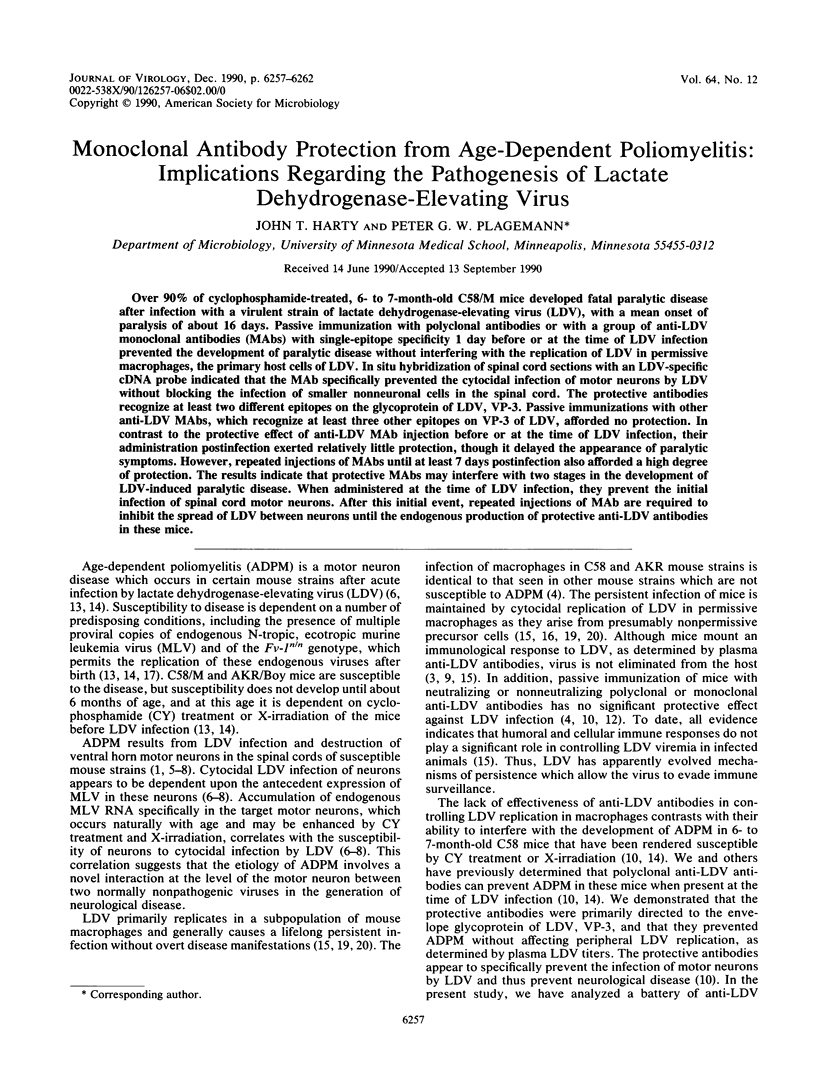
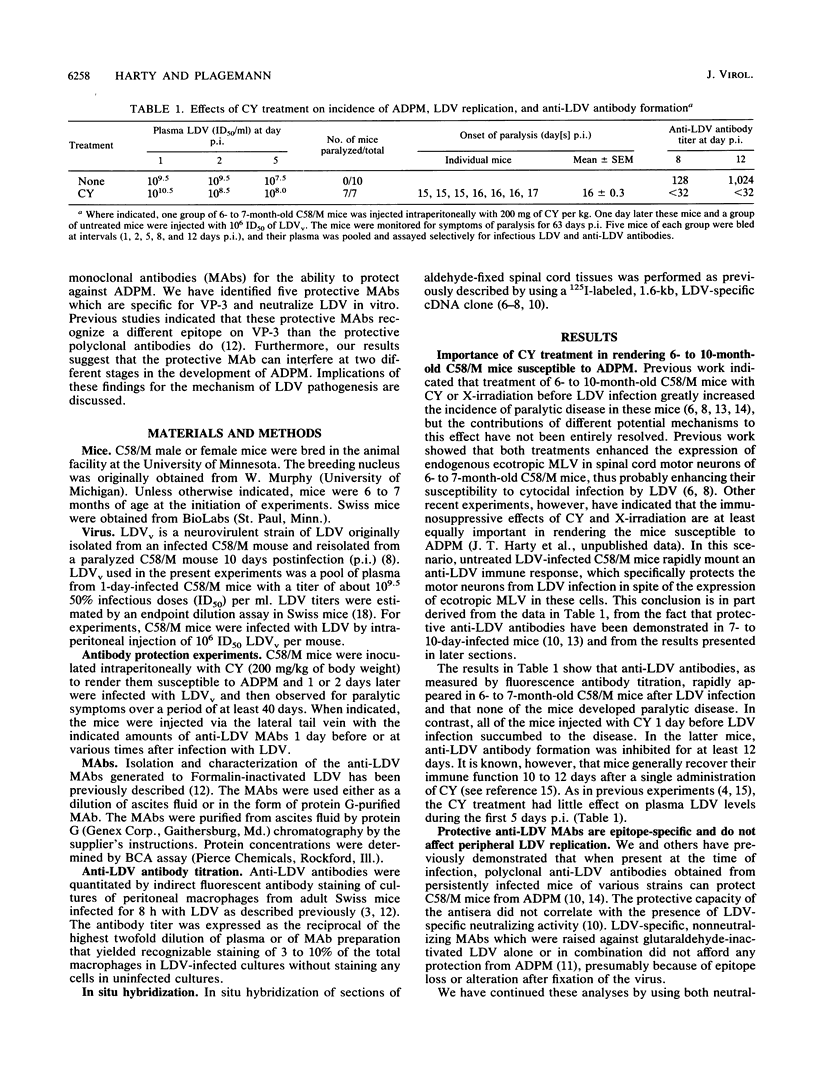
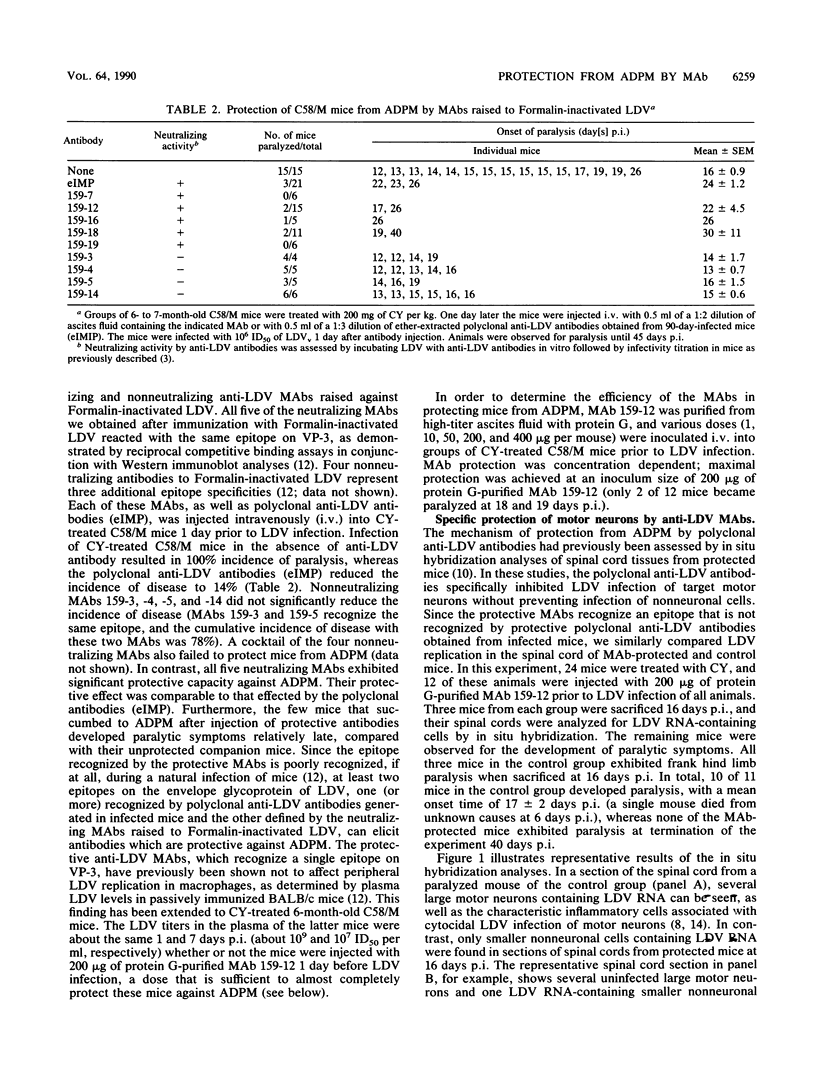
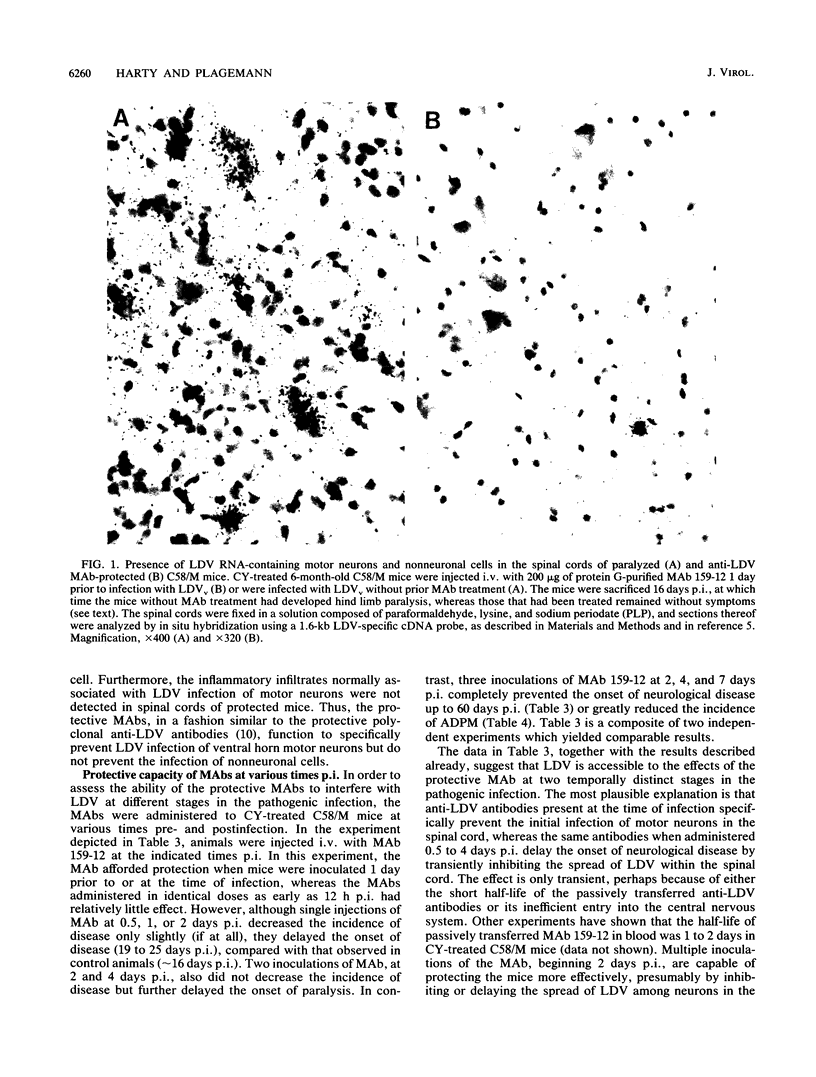
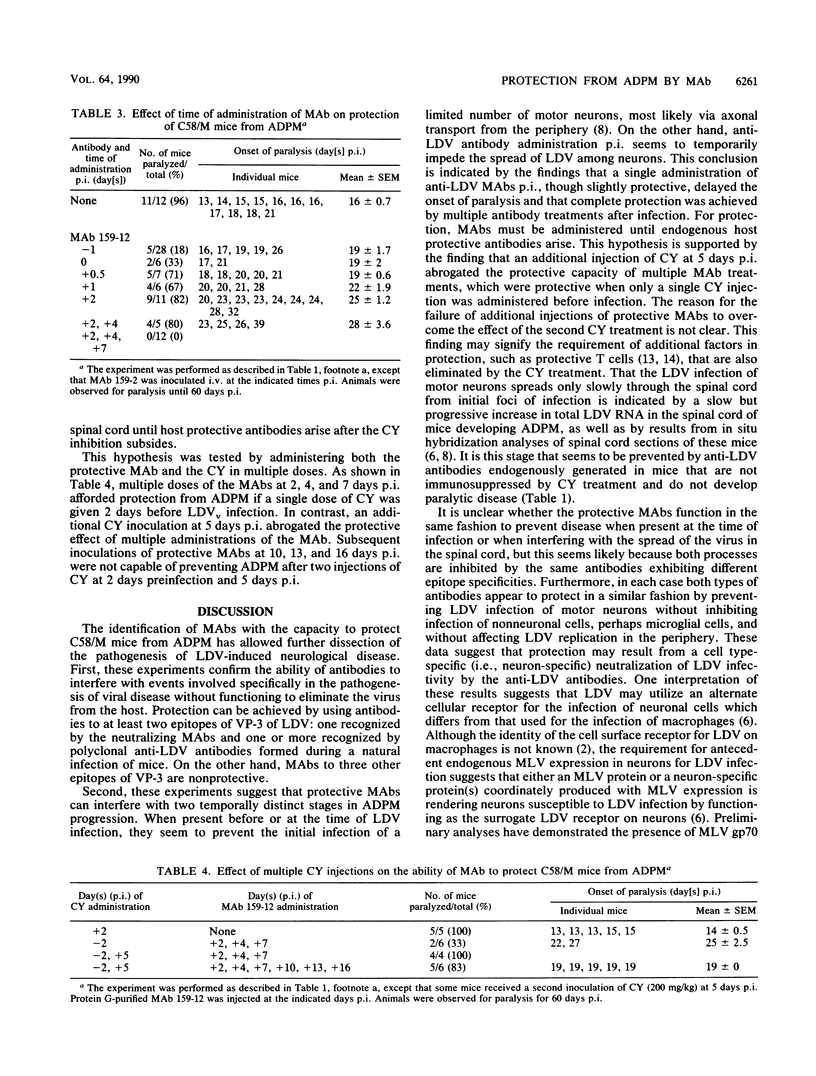
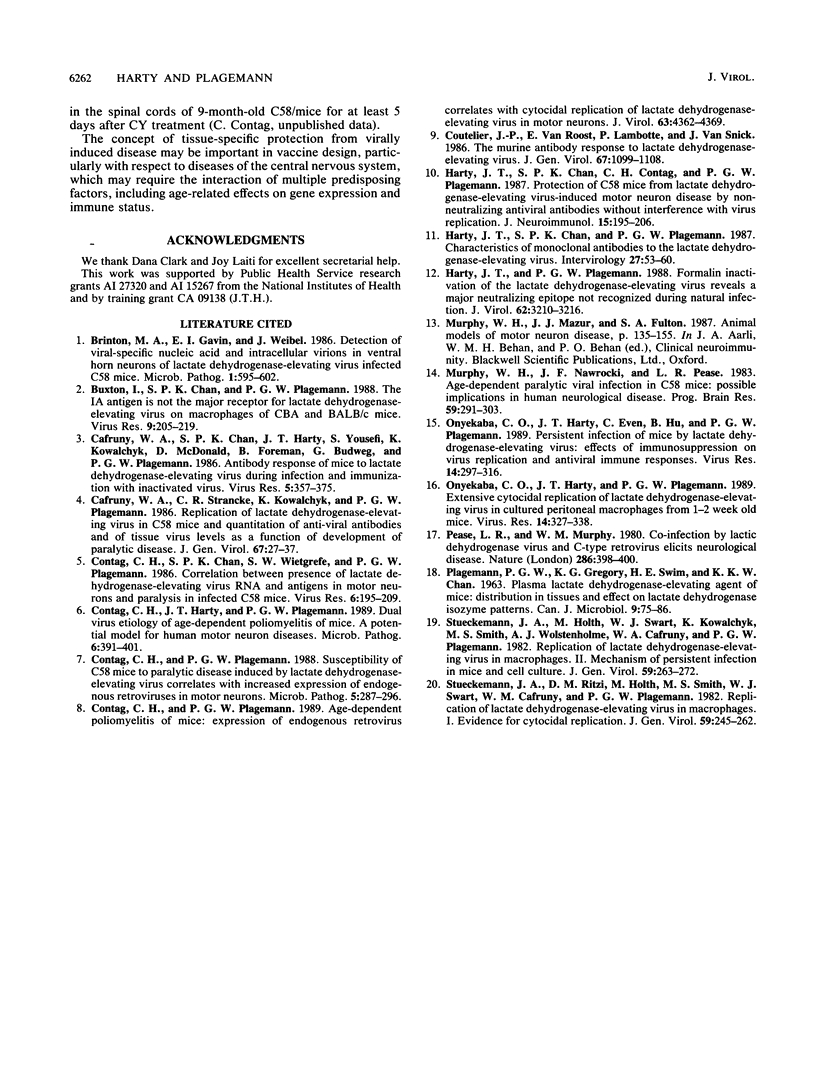
Images in this article
Selected References
These references are in PubMed. This may not be the complete list of references from this article.
- Brinton M. A., Gavin E. I., Weibel J. Detection of viral-specific nucleic acid and intracellular virions in ventral horn neurons of lactate dehydrogenase-elevating virus infected C58 mice. Microb Pathog. 1986 Dec;1(6):595–602. doi: 10.1016/0882-4010(86)90044-6. [DOI] [PubMed] [Google Scholar]
- Buxton I. K., Chan S. P., Plagemann P. G. The IA antigen is not the major receptor for lactate dehydrogenase-elevating virus on macrophages from CBA and BALB/c mice. Virus Res. 1988 Feb;9(2-3):205–219. doi: 10.1016/0168-1702(88)90031-7. [DOI] [PubMed] [Google Scholar]
- Cafruny W. A., Chan S. P., Harty J. T., Yousefi S., Kowalchyk K., McDonald D., Foreman B., Budweg G., Plagemann P. G. Antibody response of mice to lactate dehydrogenase-elevating virus during infection and immunization with inactivated virus. Virus Res. 1986 Sep;5(4):357–375. doi: 10.1016/0168-1702(86)90029-8. [DOI] [PubMed] [Google Scholar]
- Cafruny W. A., Strancke C. R., Kowalchyk K., Plagemann P. G. Replication of lactate dehydrogenase-elevating virus in C58 mice and quantification of antiviral antibodies and of tissue virus levels as a function of development of paralytic disease. J Gen Virol. 1986 Jan;67(Pt 1):27–37. doi: 10.1099/0022-1317-67-1-27. [DOI] [PubMed] [Google Scholar]
- Contag C. H., Chan S. P., Wietgrefe S. W., Plagemann P. G. Correlation between presence of lactate dehydrogenase-elevating virus RNA and antigens in motor neurons and paralysis in infected C58 mice. Virus Res. 1986 Dec;6(3):195–209. doi: 10.1016/0168-1702(86)90069-9. [DOI] [PubMed] [Google Scholar]
- Contag C. H., Harty J. T., Plagemann P. G. Dual virus etiology of age-dependent poliomyelitis of mice. A potential model for human motor neuron diseases. Microb Pathog. 1989 Jun;6(6):391–401. doi: 10.1016/0882-4010(89)90081-8. [DOI] [PubMed] [Google Scholar]
- Contag C. H., Plagemann P. G. Age-dependent poliomyelitis of mice: expression of endogenous retrovirus correlates with cytocidal replication of lactate dehydrogenase-elevating virus in motor neurons. J Virol. 1989 Oct;63(10):4362–4369. doi: 10.1128/jvi.63.10.4362-4369.1989. [DOI] [PMC free article] [PubMed] [Google Scholar]
- Contag C. H., Plagemann P. G. Susceptibility of C58 mice to paralytic disease induced by lactate dehydrogenase-elevating virus correlates with increased expression of endogenous retrovirus in motor neurons. Microb Pathog. 1988 Oct;5(4):287–296. doi: 10.1016/0882-4010(88)90101-5. [DOI] [PubMed] [Google Scholar]
- Coutelier J. P., Van Roost E., Lambotte P., Van Snick J. The murine antibody response to lactate dehydrogenase-elevating virus. J Gen Virol. 1986 Jun;67(Pt 6):1099–1108. doi: 10.1099/0022-1317-67-6-1099. [DOI] [PubMed] [Google Scholar]
- Harty J. T., Chan S. P., Contag C. H., Plagemann P. G. Protection of C58 mice from lactate dehydrogenase-elevating virus-induced motor neuron disease by non-neutralizing antiviral antibodies without interference with virus replication. J Neuroimmunol. 1987 Jun;15(2):195–206. doi: 10.1016/0165-5728(87)90093-2. [DOI] [PubMed] [Google Scholar]
- Harty J. T., Chan S. P., Plagemann P. G. Characteristics of monoclonal antibodies to the lactate dehydrogenase-elevating virus. Intervirology. 1987;27(1):53–60. doi: 10.1159/000149715. [DOI] [PubMed] [Google Scholar]
- Harty J. T., Plagemann P. G. Formalin inactivation of the lactate dehydrogenase-elevating virus reveals a major neutralizing epitope not recognized during natural infection. J Virol. 1988 Sep;62(9):3210–3216. doi: 10.1128/jvi.62.9.3210-3216.1988. [DOI] [PMC free article] [PubMed] [Google Scholar]
- Murphy W. H., Nawrocki J. F., Pease L. R. Age-dependent paralytic viral infection in C58 mice: possible implications in human neurologic disease. Prog Brain Res. 1983;59:291–303. doi: 10.1016/S0079-6123(08)63874-1. [DOI] [PubMed] [Google Scholar]
- Onyekaba C. O., Harty J. T., Even C., Hu B. G., Plagemann P. G. Persistent infection of mice by lactate dehydrogenase-elevating virus: effects of immunosuppression on virus replication and antiviral immune responses. Virus Res. 1989 Dec;14(4):297–315. doi: 10.1016/0168-1702(89)90023-3. [DOI] [PubMed] [Google Scholar]
- Onyekaba C. O., Harty J. T., Plagemann P. G. Extensive cytocidal replication of lactate dehydrogenase-elevating virus in cultured peritoneal macrophages from 1-2-week-old mice. Virus Res. 1989 Dec;14(4):327–338. doi: 10.1016/0168-1702(89)90025-7. [DOI] [PubMed] [Google Scholar]
- Pease L. R., Murphy W. H. Co-infection by lactic dehydrogenase virus and C-type retrovirus elicits neurological disease. Nature. 1980 Jul 24;286(5771):398–400. doi: 10.1038/286398a0. [DOI] [PubMed] [Google Scholar]
- Ritzi D. M., Holth M., Smith M. S., Swart W. J., Cafruny W. A., Plagemann G. W., Stueckemann J. A. Replication of lactate dehydrogenase-elevating virus in macrophages. 1. Evidence for cytocidal replication. J Gen Virol. 1982 Apr;59(Pt 2):245–262. doi: 10.1099/0022-1317-59-2-245. [DOI] [PubMed] [Google Scholar]
- Stueckemann J. A., Holth M., Swart W. J., Kowalchyk K., Smith M. S., Wolstenholme A. J., Cafruny W. A., Plagemann P. G. Replication of lactate dehydrogenase-elevating virus in macrophages. 2. Mechanism of persistent infection in mice and cell culture. J Gen Virol. 1982 Apr;59(Pt 2):263–272. doi: 10.1099/0022-1317-59-2-263. [DOI] [PubMed] [Google Scholar]



